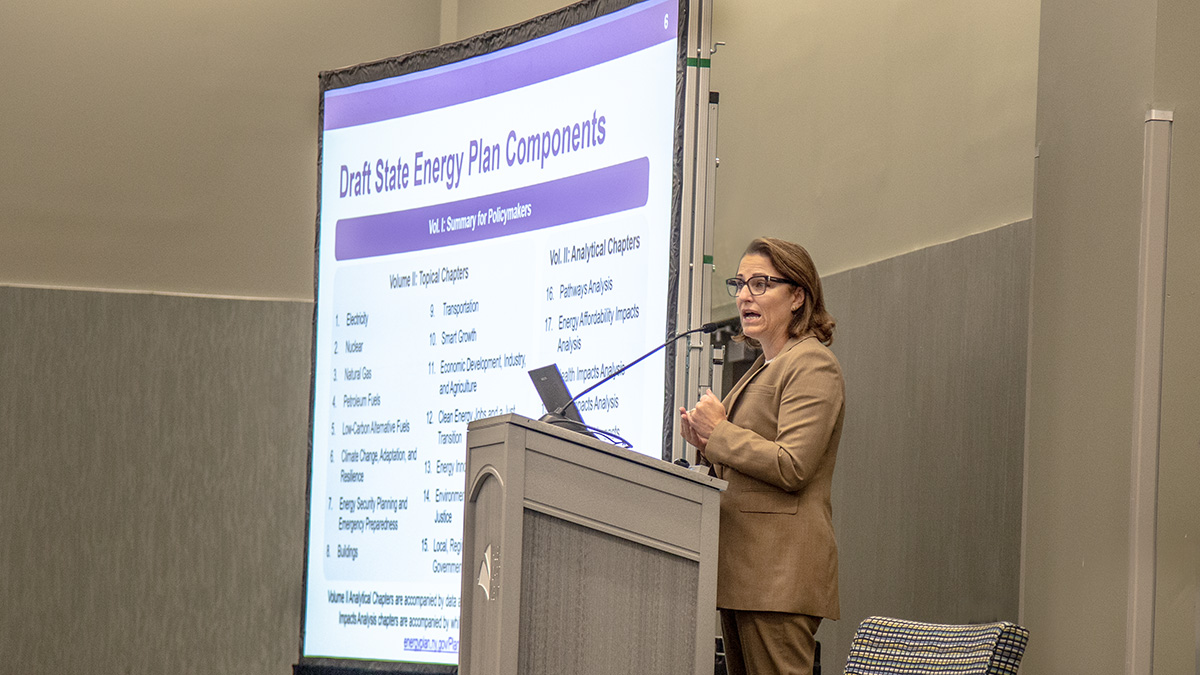EAC Explores Supply, Transmission Solutions to Grid Challenges at Fall Meeting

At its October meeting, NYISO’s Environmental Advisory Council explored growing challenges in grid planning amid shifting federal headwinds, aging infrastructure and soaring electricity demand.
The eight-member council — comprised of experts in areas of energy, technology, and environmental policy — discussed potential generation and transmission solutions to these challenges with NYISO executives and industry leaders.
“I never take for granted the opportunity to have face-to-face discussions,” NYISO Executive Vice President and COO Emilie Nelson said in her opening remarks. “It will be incredibly valuable to hear your insights on how the energy sector might proceed over the next few years given the uncertainties and tensions between the direction here in New York State and federal policies.”
The EAC was formed in 2005 to provide the NYISO with information, analysis, and perspectives on the dynamics between evolving state and federal environmental policies and the NYISO’s mission of maintaining reliability of the bulk electric system and administering competitive wholesale electricity markets.
NYSERDA President and CEO Doreen Harris and NYSERDA’s Senior Vice President for Policy, Analysis, and Research Carl Mas opened the session with a presentation of the 2025 Draft State Energy Plan.
Harris and Mas addressed shifting federal headwinds and underscored potential changes to the forthcoming State Energy Plan, which urges continued state support for the deployment of clean energy resources as outlined in the Climate Leadership Community Protection Act (CLCPA), while also taking strategic steps to navigate looming challenges.
Harris, who is the chair of the Energy Planning Board and was also a co-chair of the state’s Climate Action Council, said while the Council’s Scoping Plan provides recommendations for pursuing the CLCPA’s ambitious goals, the state’s routinely updated Energy Plan analyzes the impact of current state policy under a range of different scenarios and makes recommendations for advancing energy-related goals.
“We always knew that the level of transformation that would be necessary in our economy to reach the goals of the CLCPA was disruptive,” said Harris.
The proposed energy plan also bolsters the NYISO’s calls for repowering aging power plants and developing new energy resources to support reliability.
The Energy Plan examines different future scenarios, and from pathways that include additional delays in the building out of new generation and transmission infrastructure, “we are seeing a need for repowering more gigawatts. We are seeing a ‘sooner and more’ need for repowering our fossil fleet,” Mas said.
A set of panel discussions then explored the feasibility of solutions like hydrogen generation, nuclear energy, carbon capture, repowering, and transmission enhancing technology to help meet demand during the renewable transition.
The first panel, moderated by NYISO Director of Grid Transition Udayan Nair, explored supply solutions to help advance the transition. Panelists included Tom Bourgeois of the Pace Land Use Center for Sustainability; Daniella Piper, Executive Vice President and Chief Innovation Officer at the New York Power Authority (NYPA); John Reese, Principal of Morningsidenergy; and Zach Smith, Senior Vice President of System and Resource Planning at the NYISO.
Reese illustrated the disparities in carbon impact and efficiency for various types of gas generators that currently support New York’s electric grid.
“Every megawatt that [older power plants] run today, they are just a massive problem, and in fact, going forward as we look at load growth, with having lost a lot of our solutions in New York City, those units are going to run more,” Reese said.
“In addition to thinking about the needs of today, we have to prepare for a future that we imagine,” Piper said.
Most recently, NYPA has been tasked with developing at least one new zero-emission advanced nuclear power plant with a minimum capacity of one gigawatt.
“We are committed to building a gigawatt of nuclear in upstate New York,” Piper said. “We have not made a decision whether it will be a large modular nuclear plant or it will be multiple plants. We are going through the process of prefeasibility.”
The second panel, “Bridging the Transition with Transmission Investment,” moderated by EAC member and Columbia University professor Daniel Zarrilli, explored transmission investment and grid enhancements that can help meet projected increases in demand.
Jason Frasier, NYISO Senior Manager of Transmission Planning, offered an overview of the NYISO’s transmission planning processes and its System and Resource Outlook planning study, and transmission projects underway.
Paul Haering, Vice President of Capital Investments at NY Transco, highlighted bureaucratic and logistical hurdles to building new transmission lines, while hailing achievements like the ongoing development of Propel New York which will strengthen ties between Long Island and the rest of New York.
“We were woefully underinvesting in transmission system ... with a lot of projects that have been identified in the last 10 years, but we have made significant strides in improving that process,” Haering said.
Panelist and EAC member Erik Ela, Director of Energy Systems Integration Group, talked about grid enhancing technologies, which can improve power flow and reduce congestion on the transmission system.
Alicia Gené Artessa, Director of NY Offshore Wind Alliance highlighted the potential for offshore wind to significantly bolster New York’s grid while acknowledging funding challenges for transmission lines needed to transfer the offshore generated megawatts to dry land.
“New York is as big as some countries with offshore wind. New York has the size, it has the budget, and if we continue investing, we can be competitive on the global market,” Artessa said.
